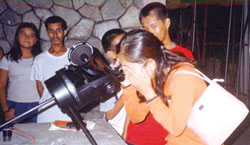 With the entire nation busy assessing the country's history in order to chart a roadmap to the future, why should we stargazers be left out?
With the entire nation busy assessing the country's history in order to chart a roadmap to the future, why should we stargazers be left out?
The remnants of stone-henge (chhate-dhunga) in Tehrathum andother districts show that during the Middle Ages, Nepali astronomers used such structures to track the position of the Sun (solstices and equinoxes). In 1790 AD, Laxmi Dutta Pande made the first sundial (dhup ghadi), which is now kept at the National Museum. In 1910, Bir Sumsher installed a sundial at Ghantaghar with support from the British. In the early 1970s, Prof Keshav Ram Joshi of Balmiki College brought the first telescope to Nepal from Russia and organized public observations at Tundikhel.
However, institutional initiatives to develop astronomy were taken only in 1995, when the government established the BP Koirala Planetarium and Science Museum Development Board. Over the past decade, the board has been unable to run neither the planetarium nor the observatory. It has been reported that the Board recently acquired a 16-in telescope, only to find out later that they don't have the skills to operate it! This is certainly irresponsible behaviour and misuse of scarce public resources.
Now, with BP Koirala's brother GP in power, amateur astronomers are expecting that the Planetarium Development Board will be reshuffled to make it more result-oriented. It is highly embarrassing that, four centuries after the telescope was invented, astronomy in Nepal is moving at the pace of a tortoise!
The June sky
Soon after sunset, you can find the constellation Ursa Major (Saptarshi) in the northern sky. To the east of it is the beautiful constellation B??tes, the Herdsman. Virgo the Virgin will be just overhead and Leo the lion is high in the western sky. To locate Leo, look for the curve of stars that forms the lion's mane.
Immediately west of Leo is Cancer the Crab, which now houses the planets Mars and Saturn. Similarly, you could identify other prominent summer constellations, namely Hydra (the Water Snake), Scorpius, Libra (the Scales) and Hercules.
Don't miss the spectacular show of Mercury on the evening of 20 June. And train your binoculars skyward to observe the gathering of the Moon, Mars, Mercury and Saturn on the evening of 28 June.
The Sun: The summer solstice occurs on 21 June at 6.10 PM, when the Sun reaches its highest "altitude" in the sky, making this the longest day in the northern hemisphere.
Mercury: Mercury starts the month setting over one hour after sunset but each night it sets later until it reaches its greatest eastern elongation on 20 June.
Venus: Venus is the "morning star," rising about two hours ahead of the Sun.
Mars: Mars shares Cancer with Saturn during June. Watch the 'red planet' carefully this month as it moves through Cancer and approaches very close to the ringed-planet around the middle of June.
Jupiter: Jupiter is magnificent in Libra and can be seen all night.


